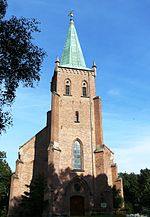Alnabru station

Alnabru Station (Norwegian: Alnabru stasjon) was a railway station on the Trunk Line located in the Alnabru neighborhood of Oslo, Norway. Situated 6.50 kilometers (4.04 mi) from Oslo Central Station, it was built primarily as a cargo handling station, although it also served passengers. The station building was designed by Finn Ivar Andreas Knudsen. The station opened on 20 January 1902 at the same time as the Trunk Line received double track. It was named Alna until 1 May. The Alna Line was built as a branch of the Gjøvik Line, allowing cargo trains to run to Alnabru. The Loenga–Alnabru Line opened in 1907, connecting the Østfold Line to Alnabru. The station remained in service until 14 June 1971. It was thereafter demolished to make room for Alnabru Freight Terminal. The Trunk Line was moved around the terminal and Alna Station opened on it to serve commuter trains.
Excerpt from the Wikipedia article Alnabru station (License: CC BY-SA 3.0, Authors, Images).Alnabru station
Alnabruveien, Oslo Alna
Geographical coordinates (GPS) Address Nearby Places Show on map
Geographical coordinates (GPS)
| Latitude | Longitude |
|---|---|
| N 59.929166666667 ° | E 10.836388888889 ° |
Address
Alnabruveien
Alnabruveien
0582 Oslo, Alna
Norway
Open on Google Maps










